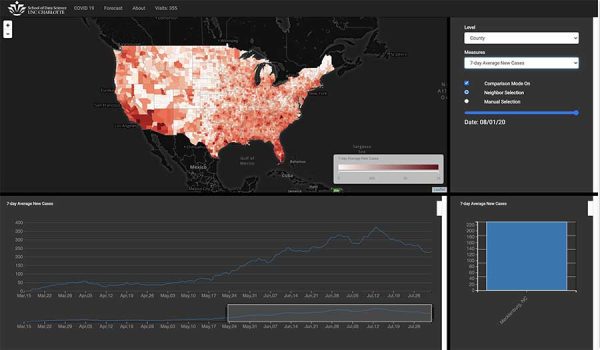Visualizing the COVID-19 pandemic

As the United States battles a drastic resurgence in coronavirus cases, a group of UNC Charlotte researchers aggregated, analyzed and visualized publicly available COVID-19 data to produce an interactive dashboard in order to better understand the rapid spread of the virus.
“Mapping this data over a number of weeks has allowed us to visualize the relationship between the geographic patterns of hotspots and cold spots and the geographic patterns of social distancing,” said Jean-Claude Thill, a UNC Charlotte economic geographer and collaborator on the project. “This unique feature uncovers valuable information for government leaders and public health officials to determine where social distancing efforts have been successful, and where additional measures are needed to reduce the spread of the virus.”
UNC Charlotte’s School of Data Science facilitated this project with a $27,000 grant to the school from a Fortune 500 financial services company that has a strong presence in the Charlotte community.
Employing U.S.-, state- and county-level data on COVID-19, the University interdisciplinary research team measured new and total cases, new and total deaths, seven-day average of new cases and duration spent at home from March 18 through Aug. 5. The team’s dashboard utilizes a statistical technique and geospatial computational algorithm to identify “clusters” and infection hotspots and cold spots throughout 3,600 counties across the country.
University collaborators on the project include Rajib Paul, associate professor, Department of Public Health Sciences; Shi Chen, assistant professor, Department of Public Health Sciences; Jean-Claude Thill, affiliate professor, Department of Geography & Earth Sciences; and Doug Hague, executive director, School of Data Science.
Graduate and Ph.D. student collaborators include Atefeh Mahdavi Goloujeh, candidate for a Ph.D. in Computing and Information Systems